Introduction
The western drywood termite, Incisitermes minor (Hagen), is the most common structure-infesting drywood termite in the southwestern United States. Originally described as Kalotermes minor by Hagen (1858), I. minor was reclassified into the genus Incisitermes by Krishna (1961). In California, Incisitermes minor infestations are still sometimes referred to by some pest control operators as "Kalos" and designated with a "K" on termite inspection reports. Currently, there is only one Kalotermes species in the United States (Kalotermes approximatus (Snyder), found in Florida and the southeastern US north to Virginia). Some members of the Kalotermitidae are called drywood termites because colonies live entirely within sound, dead, dry wood. Drywood termites do not require any contact with the ground.
Distribution
Incisitermes minor is found in the coastal and lower mountain regions of southern California. Its range extends up the coast to northern California and onward in a discontinuous distribution along the coasts of Oregon and Washington. It is also found extensively in the central valley of California up to Sacramento and in isolated pockets in the high desert where trees are present. Towards the east, I. minor's range extends to central Arizona and southward it extends into Baja California and Sonora, Mexico. The relative ease of intracontinental travel and commerce coupled with the fact that infested wood can be easily transported has resulted in isolated occurrences of I. minor infestations throughout the United States, including Florida. Infestations have been found in China and it is well established in Japan.
Infestations have also been found in Arkansas, Iowa, Maryland, New Jersey, New York, Oklahoma, Ohio, and Texas. A heavily infested structure was reported in Toronto, Canada (Grace et al. 1991). Recently, I. minor has been found in Georgia (Scheffrahn et al. 2001), South Carolina (Hathorne et al. 2000) and Louisiana (Messenger et al. 2000). The latter is significant to Florida because I. minor was taken from a park tree in New Orleans indicating that it can survive outdoors in a non-Mediterranean, subtropical climate. This apparently was the case with three boat infestations in Florida where termites and damage were found in wood located outside the cabins. In southern California and Florida, yachts, sailboats, and small pleasure craft harboring mature colonies may serve as floating sources of introduction outside I. minor's native range as they set sail for ports of call around the world.
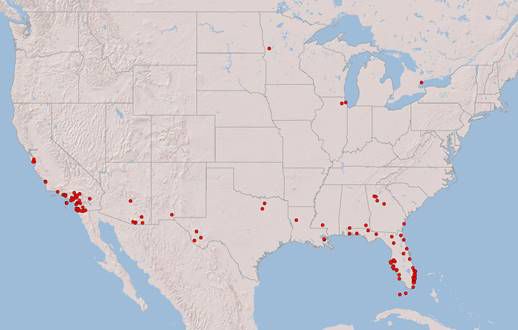
Description and Identification
The western drywood termite is not a "typical" Incisitermes in that several characteristics (color, wings, ocellus, arolium, soldier eye, etc.) are distinct from most other species of Incisitermes.
Alate (Swarmer)
Alates are winged male and female termites and are the only caste that, during dispersal flights, leaves the colony. If successful in mating, some will become royal pairs—the kings and queens of new colonies. The western drywood termite alate has an orange-brown head and pronotum, and a dark brown abdomen. The wings are dark with a somewhat smoky tint to them. Alates are 11 to 12.5 mm long, including the wings.

Credit: R. H. Scheffrahn, UF/IFAS
Soldier
The soldiers have large, reddish-brown head capsules that are heavily sclerotized. The mandibles are large and black with two prominent teeth visible on the inner margin of the left mandible. Western drywood termite soldiers are recognized by the enlarged, club-like third antennal segment that is as long or longer than the fourth through sixth antennal segments combined. Soldiers of mature, older colonies are large, ranging from 8 to more than 12 mm long and weighing as much as 20 to 25 mg.

Credit: R. H. Scheffrahn, UF/IFAS
Workers
Drywood termites lack true workers, a terminal caste which is reproductively sterile and found only in the Termitidae. Instead, drywood termite workers are called "pseudergates" (literally false workers) if they lack wing pads or "nymphs" if wing pads are present. The workers develop from earlier instars that are often referred to as larvae, even though termites go through simple metamorphosis. Pseudergates are not sterile or a terminal caste, therefore they maintain the capability of molting into a soldier, a supplementary reproductive (neotenic), or an alate.
Video of western drywood termites.
Comparison with the West Indian Powderpost Drywood Termite,Cryptotermes brevis(Walker)
Incisitermes minor is a much bigger species and has larger colonies than C. brevis, the most common structure-infesting drywood termite in Florida. The enlarged third antennal segment of I. minor and the phragmotic head of C. brevis easily separate the soldiers of these two species. The orange-brown head and smoky tinge to the wings of I. minor also distinguishes the alates from those of C. brevis. Western drywood termites infest both natural and structural wood while C. brevis is found only in structural wood. Both species produce characteristic hexagonal fecal pellets but those of I. minor are larger (mean 0.98 mm long) than those of C. brevis (mean 0.87 mm).
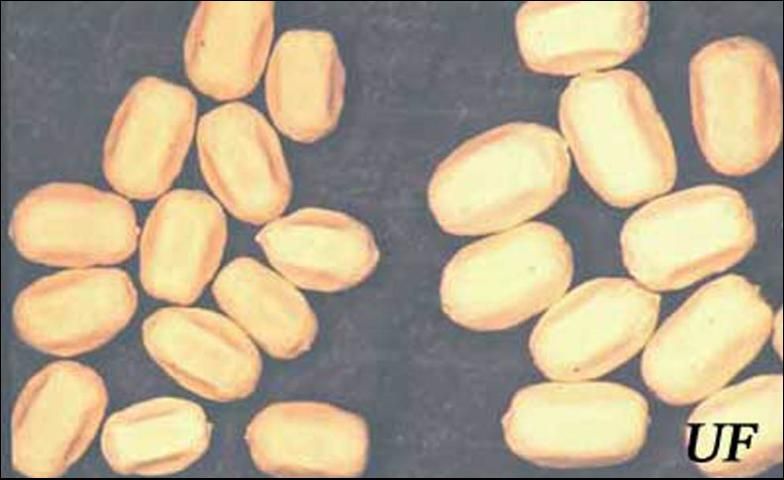
Credit: B. J. Cabrera, UF/IFAS
Biology
Harvey (1934) provides a highly detailed description of the biology and life history of I. minor. The life cycle is typical for that of other drywood termites.
Western drywood termite alates fly during the day and in southern California swarm from late September through November. In desert areas, where average daytime temperatures are warmer, they may swarm much earlier in the year. For instance, in Palm Springs, CA, swarming flights have been observed as early as May. Swarming has been seen in April from warm indoor locations such as water heater closets and in laboratory colonies. In Florida, dispersal flights (all recorded indoors and during daytime) have occurred in all months of the year except December with 50% of the flights occurring in September, October, or November.
Swarming usually occurs on bright, sunny days with temperatures between about 26.7 to 37.8°C (80 to 100°F). Alates emerge from exit holes in the wood and are attracted to light (positive phototaxis). Upon reaching the outside, the swarmers take off in all directions. They are relatively poor fliers, being neither particularly fast nor agile, and can easily be caught by hand. Harvey (1934) estimated flight and distances traveled by I. minor alates during swarming. Weak fliers sustained short flights of only six to 10 feet at a time. Intermediate fliers traveled from 75 to 100 feet, and stronger fliers traveled 200 to 250 feet from the point of emergence. Upon landing, I. minor alates drop their wings by bracing their wing tips against the substrate and then twisting and turning so that the wings break off at the base. The wingless alates (dealates) crawl about in search of a mate and, if one is found, the pair engages in courtship activity. This includes tandem running in which the female scurries about with the male in tow. Once the female accepts a male, the pair, now referred to as the king and queen, remain mates for life. Their first task as a royal pair is to find a crack, crevice or hole in a piece of wood where they can start excavating a royal cell. This usually takes three to four days and when completed they seal the entrance with a plug of gut contents. Following a period of inactivity that may last up to approximately nine months, the queen begins laying eggs. Larvae hatch from the eggs and are fed by the king and queen until they are large enough to feed and excavate galleries in the host wood.
After two years, the colony is still quite small consisting of the king and queen, a soldier, and perhaps a dozen or so nymphs (Harvey 1934). Over time, the size of the queen's ovaries increases and the abdomen swells—a condition known as physogastry. The physogastric abdomen appears striped because the swelling stretches the abdominal intersegmental membranes so that each individual abdominal sclerite becomes visible. The king, however, does not change much in appearance, although he does shrink a bit, and looks virtually the same as when he first dropped his wings.
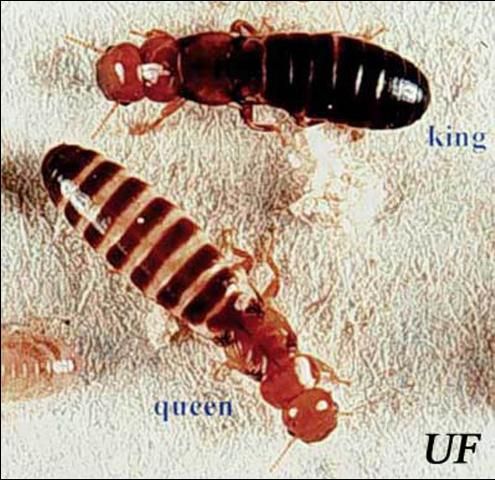
Credit: B. J. Cabrera, UF/IFAS
The queen lays most of her eggs from late spring and into late fall. According to Harvey (1934), the queen will lay approximately two to five eggs during the first year, approximately eight to 15 eggs during her second year, and her fecundity increases with each successive year until a plateau is reached after 10 to 12 years. It may take five to seven years before an incipient colony produces visible feeding damage or is found infesting wood. Harvey (1934) reports that a 5-year old colony consists of the primary king and queen, 20 soldiers and 500 nymphs. At 10 years, one or more supplementary reproductives may be present in addition to the primaries, plus 70 soldiers and 1,600 nymphs. At 15 years, there may be one or more supplementaries plus the primaries, 120 soldiers and 2,600 nymphs. These estimates are subject to considerable variation as the population size and growth is influenced by numerous environmental factors such as temperature, and the amount and nutritional quality of the host wood.
Although Harvey (1934) acknowledged secondary reproductives may appear in the colony to supplement egg production, the existence of more than one pair of functional reproductives in an I. minor colony—even in older, larger ones—remains unlikely. Luykx (1986) believed that what appeared to be extra reproductives in colonies of I. schwarzi were probably the result of a mixture of two different colonies. Atkinson (unpublished) examined the caste composition of 38 I. minor colonies and never found more than one pair of reproductives in a colony. However, he noted that some replacement reproductives may not have been fully melanized (darkened) and could have been overlooked in colonies in which no reproductives at all were found.
Incisitermes minor has at least seven instars and it probably takes more than a year for a nymph to develop from the egg to an alate or soldier (Harvey 1934). The duration of each instar is variable depending on prevailing environmental conditions and available resources. The average size of the fifth to seventh instar ranges from approximately 6.5 to 9. 5 mm long and they weigh from 10 to 15 mg. Western drywood termite nymphs have relatively large amounts of fat body and the larger nymphs are very robust. The percent fat content of dry weight of late instar nymphs is approximately 18 percent (K. Haagsma, unpublished data).
The galleries of I. minor are typical of other drywood termite species, albeit a bit larger and more cavernous. They consist of irregular excavations that extend throughout the sapwood, across both spring and summerwood, and sometimes into the heartwood. Some galleries are spacious enough to accommodate large aggregations of termites while others are so narrow that termites can only pass through in single file. Another characteristic feeding behavior is that I. minor will excavate towards the outer surface of the wood without actually breaking through it, thus leaving a paper thin, outer protective layer. Infested wood sometimes appears sound, but upon close inspection and mechanical probing this outer shell can be easily broken, revealing the underlying galleries and large amounts of frass (fecal pellets).
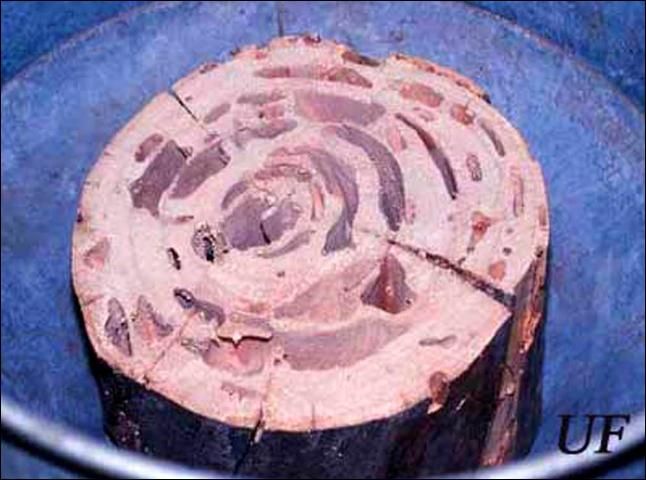
Credit: B. J. Cabrera, UF/IFAS
Incisitermes minor is well adapted to living in arid habitats. Its natural geographic range includes many areas of low precipitation and high summer temperatures. Furthermore, sound wood under some extremely dry conditions, such as those found in inland Southern California on hot, summer afternoons, contains only about six to seven percent water. Western drywood termites obtain water either directly from the wood on which they feed or they produce it themselves through oxidative metabolism (Becker 1969). Drywood termites also have another adaptive mechanism for conserving water. Undigested matter in the alimentary canal passes through specialized rectal glands in the hindgut. These glands reabsorb water from the feces producing a dry pellet with a distinctive hexagonal shape. The pellets are quite small, weighing approximately 0.10 to 0.15 mg, and feel dry and gritty when rolled between the fingers. The presence of pellets, sometimes found in piles, is a very characteristic sign of infestation. Homeowners often mistake this for sawdust and are unaware of what these peculiar pellets actually are. Drywood termites expel their fecal pellets from the gallery through "kickout" holes. These holes are extremely small and usually are sealed with a plug of wet feces and pellets when not in use. They can sometimes be found by carefully searching wood surfaces directly above where fecal pellets accumulate.
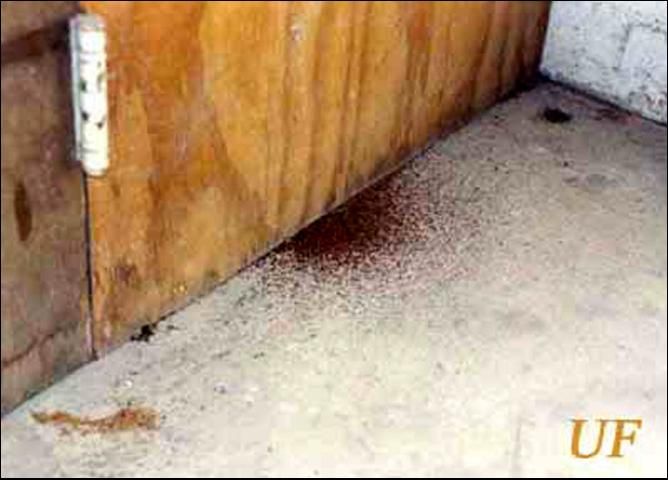
Credit: B. J. Cabrera, UF/IFAS
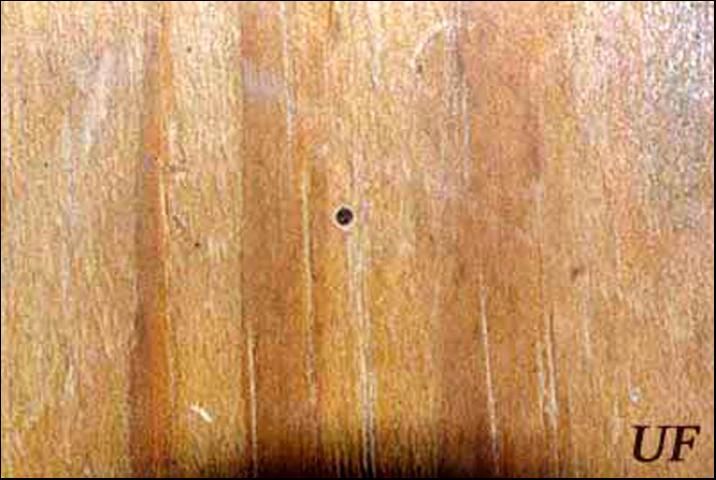
Credit: B. J. Cabrera, UF/IFAS
Habitat
In California, I. minor occurs naturally in oak and riparian woodlands, river washes and canyons with trees. Colonies are often found in the dead portions of California laurel, willow, cottonwood, oak, and sycamore trees and in stumps, downed logs, and large, dead branches on the ground. In urban and suburban areas, I. minor is often found in rose, Pyracantha, and oleander bushes, and alder, almond, apricot, ash, avocado, carob, cherry, citrus, elderberry, mulberry, ornamental pear, peach, plum, and walnut trees. The western drywood termite infests sound, dry wood in human-made structures, as well as furniture, and other wooden items.
In Florida, Incisitermes minor has a spotty distribution from the Panhandle down to Miami (where it was probably first introduced into Florida [Hickin 1971]) and has been found on both coasts of the peninsula. Scheffrahn et al. (1988) reported two incidences of infestation and since then there have been 22 more confirmed records (Scheffrahn, unpublished data). Of all records, three occurred on boats—two of these from Southern California—that were subsequently fumigated. Three other infestations were associated with furniture that was traced to the Pacific Coast. So far, all the Florida infestations have only been found in structural lumber, not in natural wood.
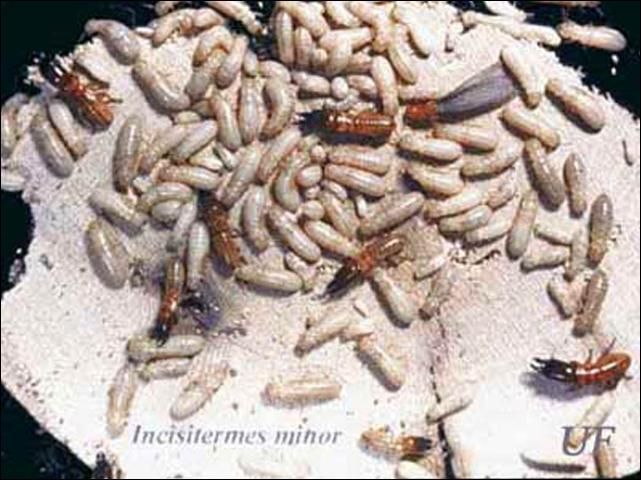
Credit: R. H. Scheffrahn, UF/IFAS
In one case study, conducted in the laboratory at the UF/IFAS Fort Lauderdale Research and Education Center, I. minor workers in structural lumber initiated a large infestation. In April 1990, western drywood termite-infested wood was cut into sections and placed on a laminate-covered plywood bench top not previously exposed to I. minor. A few days later, workers were observed trailing from the exposed wood galleries to the juncture between the bench top and wall. Over the years, fecal pellets were observed falling from the bench top. In 2000, the entire 24 foot length of the bench top had pellets falling from it. Known flights from the bench top occurred in September 1999 and July 2001.
Economic Importance
Incisitermes minor is a tremendous pest in California and Arizona with an estimated annual economic impact of $250 million (M. Rust, unpublished), mainly in damage and treatment costs. A survey of structural inspection reports conducted in San Bernardino, Riverside, and Orange counties in southern California between September 1992 and April 1993 revealed that the western drywood termite accounted for approximately 55 percent of the total inspections for wood-destroying organisms. Near the coast, they accounted for >75 percent of the inspections (T. Atkinson, unpublished data). The western drywood termite will continue to torment homeowners and keep termite control companies busy, especially in newly developed areas in California where urban sprawl is running rampant. Further infestations are likely to be discovered in Florida.
Management
There are a variety of treatments for controlling drywood termite infestations (see https://www.researchgate.net/publication/266894463_Drywood_Termite_Control_Weighing_All_the_Options). The type used depends on several factors including severity, location, economics, tolerance level, and attitudes towards pesticide use.
Fumigation of a structure, usually with sulfuryl fluoride, is recommended for severe or widespread infestations, or when they are in inaccessible areas. This treatment is the most effective in ensuring the whole structure is treated and all termites within are killed. On the minus side, it is expensive, highly disruptive (usually one night must be spent away from home), and it does not provide residual protection.
When infestations are limited, easy to find, and are in easy to reach areas, they can be given a localized treatment. These "spot" treatments consist of drilling holes into the infested wood or opening kickout holes and injecting a termiticide into the galleries. Control is sometimes as simple as removing and discarding infested wood. This can be done for wood members that can be easily removed from a structure and when infestations are limited to only one or a few pieces of wood such as a door, fence post, or dead branch on a tree, for example.
Public wariness over the use of pesticides and toxic chemicals in urban environments and the phase-out of methyl bromide (at one time a widely used fumigant) has spurred the development of alternative or non-traditional treatments for drywood termites. Heat treatment involves enclosing an infested structure or isolated parts of it with tarpaulins and blowing heated air inside to produce high lethal temperatures inside the wood. Cold treatment consists of filling wall voids or areas enclosed within a thermally-insulated cover with liquid nitrogen to freeze termites in the wood. Microwave devices produce thermal energy that is directed towards infested wood and literally cooks the termites within their galleries. The electrogun is a device that delivers high voltage, low current electricity to infested wood and electrocutes drywood termites inside their galleries. All four of these treatments can be effective if done properly but each has its own set of limitations (see https://www.researchgate.net/publication/266894463_Drywood_Termite_Control_Weighing_All_the_Options). Operator expertise and precisely locating the infested areas are especially important for the latter two and can have a tremendous impact on the treatment's effectiveness (Lewis and Haverty 1996).
Selected References
Becker VG. 1969. Rearing and testing methods in the laboratory, pp. 351–385. In K. Krishna and F.M. Weesner [eds.], Biology of Termites, Vol I. Academic Press, New York.
Grace JK, Cutten GM, Scheffrahn RH, McEkevan DK. 1991. First infestation by Incisitermes minor of a Canadian building (Isoptera: Kalotermitidae). Sociobiology 18:299–304.
Hagen HA. 1858. Monographie der termiten. Part 2. Linnaean Ent. 12: 1–342.
Hickin NE. 1971. Control of drywood termites, pp. 169–186. In Hickin NE, Termites -- A World Problem. Hutchinson & Co., Ltd., London.
Harvey PA. 1934. Biology of the dry-wood termite, pp. 217–233. In Kofoid CA, Light SF, Horner AC, Randall M, Herms WB, Bowe EE [eds.], Termites and Termite Control. University of California Press, Berkeley, CA.
Hathorne KT, Zungoli PA, Benson EP, Bridges WC. 2000. The termite (Isoptera) fauna of South Carolina. Journal of Agricultural and Urban Entomology 17: 219–229.
Krishna K. 1961. A generic revision and phylogeny of the family Kalotermitidae (Isoptera). Bulletin of the American Museum of Natural History 122: 303–408.
Lewis VR, Haverty MI. 1996. Evaluation of six techniques for control of the western drywood termite (Isoptera: Kalotermitidae) in structures. Journal of Economic Entomology 89: 922–934.
Luykx P. 1986. Termite colony dynamics as revealed by the sex- and caste-ratios of whole colonies of Incisitermes schwarzi Banks (Isoptera: Kalotermitidae). Insectes Soc. 33:221–248.
Messenger MT, Scheffrahn RH, Su N-Y. 2000. First report of Incisitermes minor (Isoptera: Kalotermitidae) in Louisiana. Florida Entomologist 83: 92–93.
Scheffrahn RH, Mangold JR, Su N-Y. 1988. A survey of structure-infesting termites of peninsular Florida. Florida Entomologist 71: 615–630.
Scheffrahn RH, Su N-Y, Chase JA, Forschler BT. 2001. New termite (Isoptera: Kalotermitidae, Rhinotermitidae) records from Georgia. Journal of Entomological Science 36: 109–113.